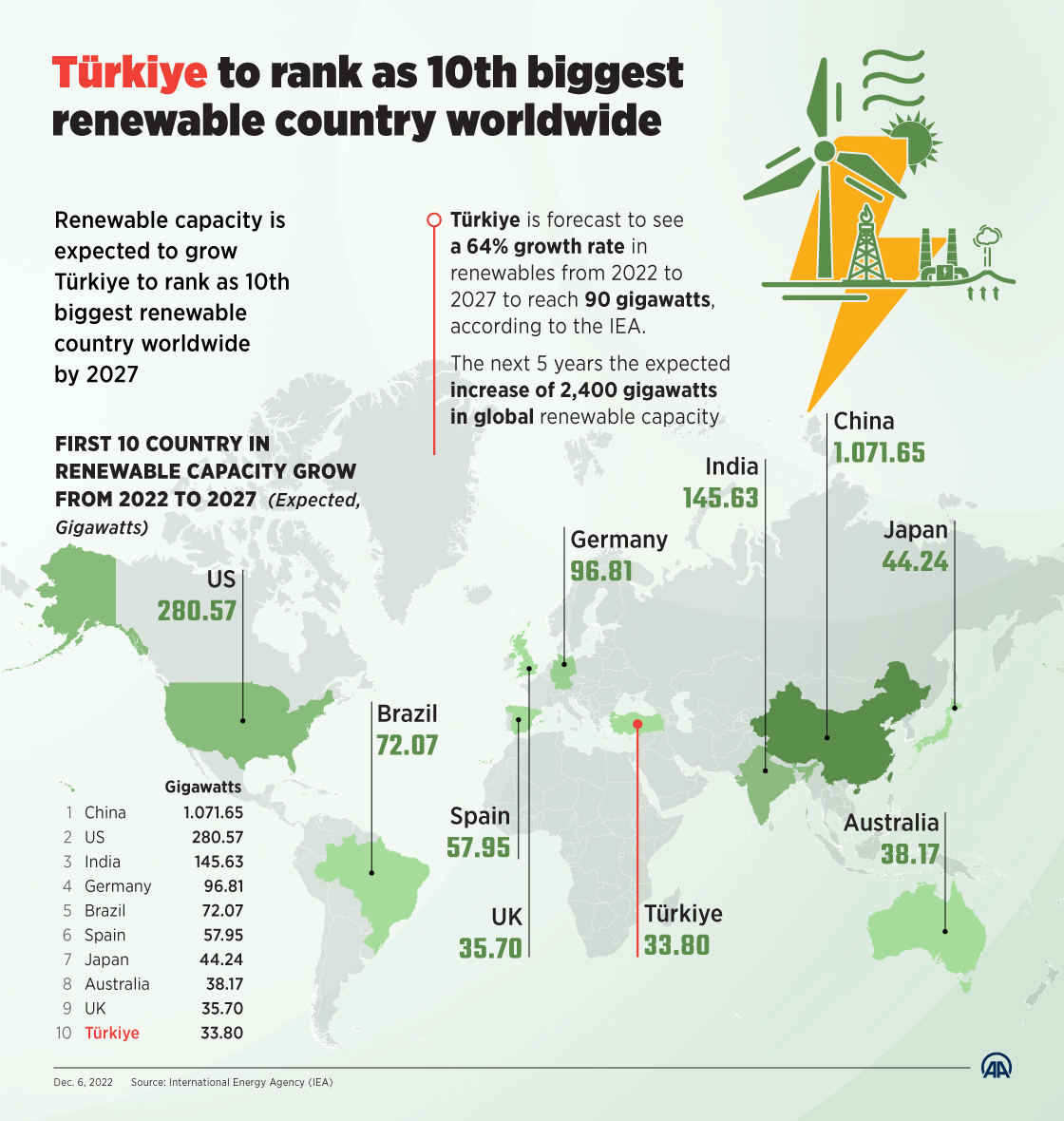Supply concerns, lower costs drive unprecedented renewables growth
Supply security and economics are more important than climate change in driving forecasted extraordinary renewables growth over next five years: IEA Chief

ISTANBUL
Global renewable energy capacity is set to double, increasing by 2,400 gigawatts over the next five years, as supply security concerns and lower renewable energy costs become the main drivers of this unprecedented growth, the head of the International Energy Agency (IEA), Fatih Birol, told Anadolu Agency in an exclusive interview.
Speaking on the IEA's annual report, Renewables 2022, Birol said the expected increase of 2,400 gigawatts in global renewable capacity is as much as the capacity added in the past 20 years and equivalent to China's current total installed power capacity.
The report reveals that the forecast increase in renewables is now 30% higher than the growth volumes anticipated one year ago.
Renewables will account for over 90% of global electricity expansion over the next five years, overtaking coal to become the largest source of electricity by early 2025, the IEA finds.
The share of renewables in the power mix is forecast to increase by 10 percentage points, reaching 38% in 2027, with renewables forecast to be the only electricity generation source expected to rise.
"There are two main drivers of this unprecedented growth. The first reason is that a growing number of countries now see renewables not only as environmentally friendly but also as a very significant contributor to the security of the energy supply. The second reason is the lower renewable costs, which are more advantageous compared to fossil fuels. Renewables have become economically viable," Birol said.
Birol further explained that the main factors for the expected growth of renewables are energy security and lower costs, not climate change.
Nonetheless, despite the very buoyant investments in clean power, which reached $1.5 trillion annually and surpassed the $1 trillion investments in fossil fuels, he stated that the growth in renewables is still insufficient to meet the climate targets of limiting global warming to 1.5 degrees Celsius.
Despite climate pledges, Birol warned of the business risks of continuing fossil fuel investments and the growing impacts of climate change.
He said the reason for the ongoing fossil fuel investments is that many investors believe the world will be unable to meet climate targets.
"We will see if their investments will be profitable or not, but still, there is a very strong appetite for renewable investments," Birol underlined.
China, India, Europe, and US drive majority of growth
Birol said that four markets, China, India, Europe, and the US will drive the majority of growth in renewables over the forecast period by providing favorable financial conditions to attract renewable investments.
China alone accounts for almost half of the anticipated growth in renewables with 1,070 gigawatts as solar and wind generate 90% of the total increase. The country is expected to reach its 2030 target of 1,200 gigawatts of total wind and solar energy five years early.
Europe's renewable electricity capacity is forecast to increase by about 60%, or 425 gigawatts, over the next five years. This corresponds to more than twice as much as in the previous five-year period.
About 75% of European expansion is concentrated in seven countries, including Germany, Spain, the UK, Türkiye, France, the Netherlands, and Poland.
The US’s renewable capacity is expected to grow by 280 gigawatts, or 74%, from 2022 to 2027, with solar and wind accounting for nearly all renewable expansion.
According to the report, cumulative solar capacity is expected to triple, exceeding 2,350 gigawatts and surpassing hydropower in 2024, natural gas in 2026, and coal in 2027 to become the largest installed electricity capacity worldwide. Solar power is expected to rise by 1,500 gigawatts over this period.
Global wind capacity is estimated to almost double, while offshore wind projects are poised to account for one-fifth of the growth in renewable energy.
Over 570 gigawatts of new onshore wind capacity are forecast to become operational over the next five years, according to the IEA.
With the rapid expansion of wind power, hydropower is falling to third place in terms of installed renewable capacity.
- One out of every two people in Africa has no access to electricity, despite the continent's robust solar potential.
India is expected to add 145 gigawatts of renewable power over the next five years.
Solar accounts for 75% of this increase, with onshore wind accounting for 15% and hydropower accounting for almost the remainder.
"Among developing countries, China and India are doing well. What I would like to focus on are the African countries, particularly the developing ones. In Africa, one out of every two people lacks access to electricity despite the continent's extraordinary solar potential," Birol said.
He reiterated that developed countries bear economic and moral responsibility for enabling renewable growth in developing countries. He, therefore, called on investment and development banks to provide concessional funds to developing countries to accelerate the growth of renewables.

Türkiye to rank as 10th biggest renewable country worldwide
Türkiye is forecast to see a 64% growth rate in renewables from 2022 to 2027 to reach 90 gigawatts, according to the IEA.
"This growth makes Türkiye the fourth-biggest renewable market in Europe and the tenth globally. We expect almost 75% of this growth to come from solar and wind," Birol said.
After a hydropower capacity of around 31,600 megawatts, the wind is the second-biggest renewable source of electricity at 11,307 megawatts. Türkiye's installed solar power reached 9,120 megawatts as of the end of October.








